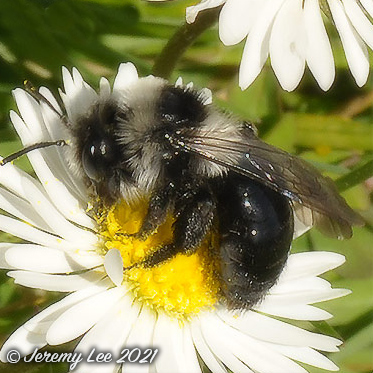
 |
|
Scientific Classifications explained » Amphibians » Ants » Aphids » Bees » Beetles » Birds » Bugs » Butterflies » Caterpillars » Damselflies » Dragonflies » Earwigs » Flies » Frog/Leafhoppers » Fungi » Galls » Grasshoppers » Harvestmen » Hoverflies » Lacewings » Ladybirds » Leaf Mines » Lichens » Mammals » Millipedes » Mosses » Moths » Sawflies » Slugs » Snails » Spiders » Trees » Wasps » Wild Flowers » Woodlice |
UK Nature > Bees > Andrena cineraria

Scientific Name: Andrena cineraria Common Name: Ashy Mining Bee Andrena cineraria, a solitary mining bee, is more commonly known as the Ashy Mining Bee. It is one of the most distinctive and obvious of all the spring flying solitary bee species over much of Britain and Ireland, and over recent years has been enjoying a marked increase in abundance in parts of its range. The females are black, and have two broad ashy grey hairbands across the thorax. The males are similar, but the thorax is entirely clothed with less dense grey hairs, and has a very pronounced tuft of white hairs on the lower face. The bee has a single flight period each year and is on the wing from early April until early June; the males emerging well before the females. Peak activity coincides with the flowering periods of fruit trees such as Pear, Cherry and Apple. The bees are non-ggressive and safe with children. Andrena cineraria nests are constructed in the ground, and the nest entrances are surrounded by a volcano-like mound of excavated spoil. Nests are often in dense aggregations in tended lawns, flower beds, mown banks and in sparsely vegetated field margins. The bee is common in gardens, parks, calcareous grassland, orchards and on the edges of cropped agricultural land. Pollen is collected from a wide range of plants which includes flowering trees and shrubs, weeds and garden species. In some areas, Andrena cineraria plays host to the uncommon cuckoo bee Nomada lathburiana. |
|

https://www.uknature.co.uk is a website dedicated to showing the immense diversity of UK nature and wildlife. Our vast range of habitats, from lowland arable to snow covered mountains, from storm-ravaged coastlines to peaceful inland freshwater lakes and rivers, from dry, sandy heaths to deciduous and coniferous forests, all these habitats contribute to the abundance of UK nature. We have wild birds in huge numbers either residing or visiting our shores (597 recorded species as at July 2013) and we must also not forget the humble back garden with its grass lawns, flower beds filled with nectar rich flowers, shrubs and trees, all designed to attract huge numbers of insects such as bees, moths, butterflies and hoverflies; and finally the small ponds which provide safe havens for frogs, toads, newts and even slow worms and grass snakes. www.uknature.co.uk is the showcase for my personal passion, photographing uknature in all its glory. I sincerely hope you all enjoy the fruits of my labours. This site and all images contained therein is © Jeremy Lee 2004 - 2021. All Rights Reserved. Site design by Jeremy Lee. Site development & IT Support by Stuart Lee. |